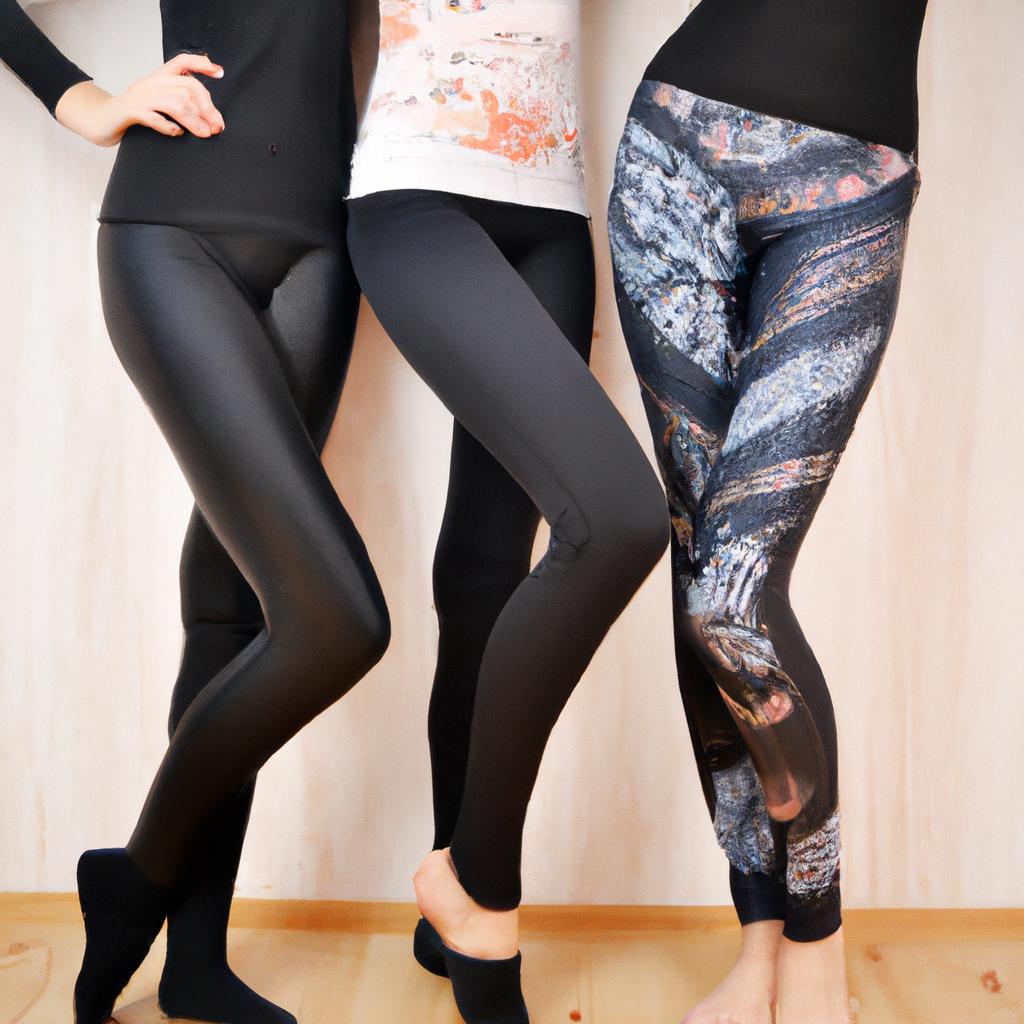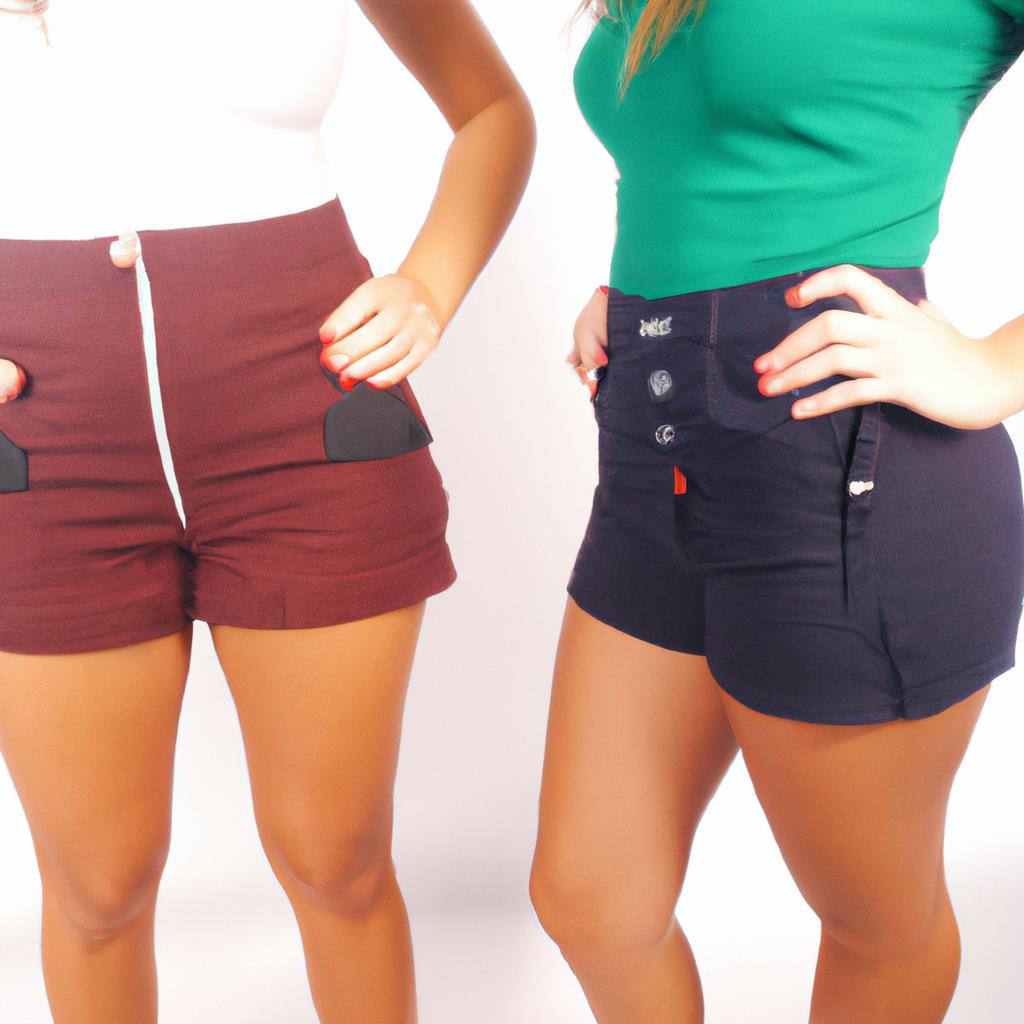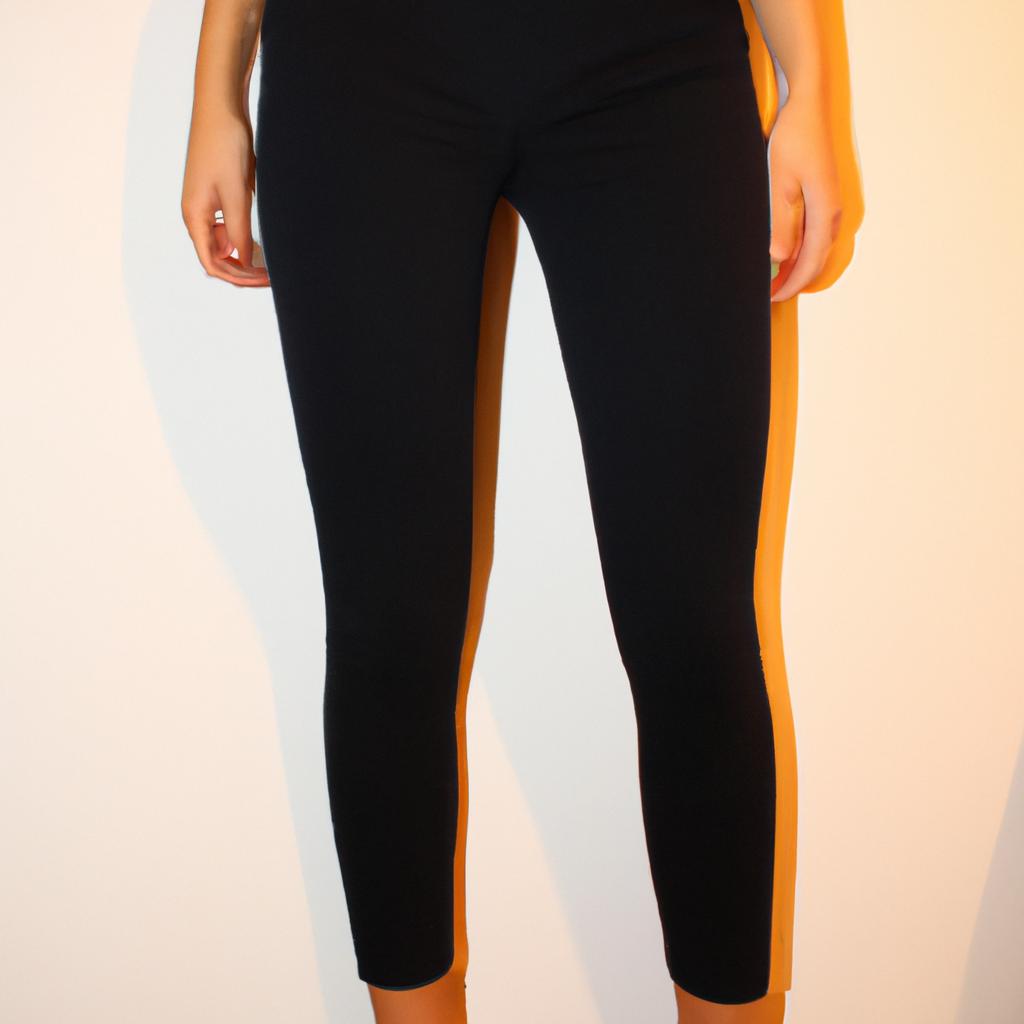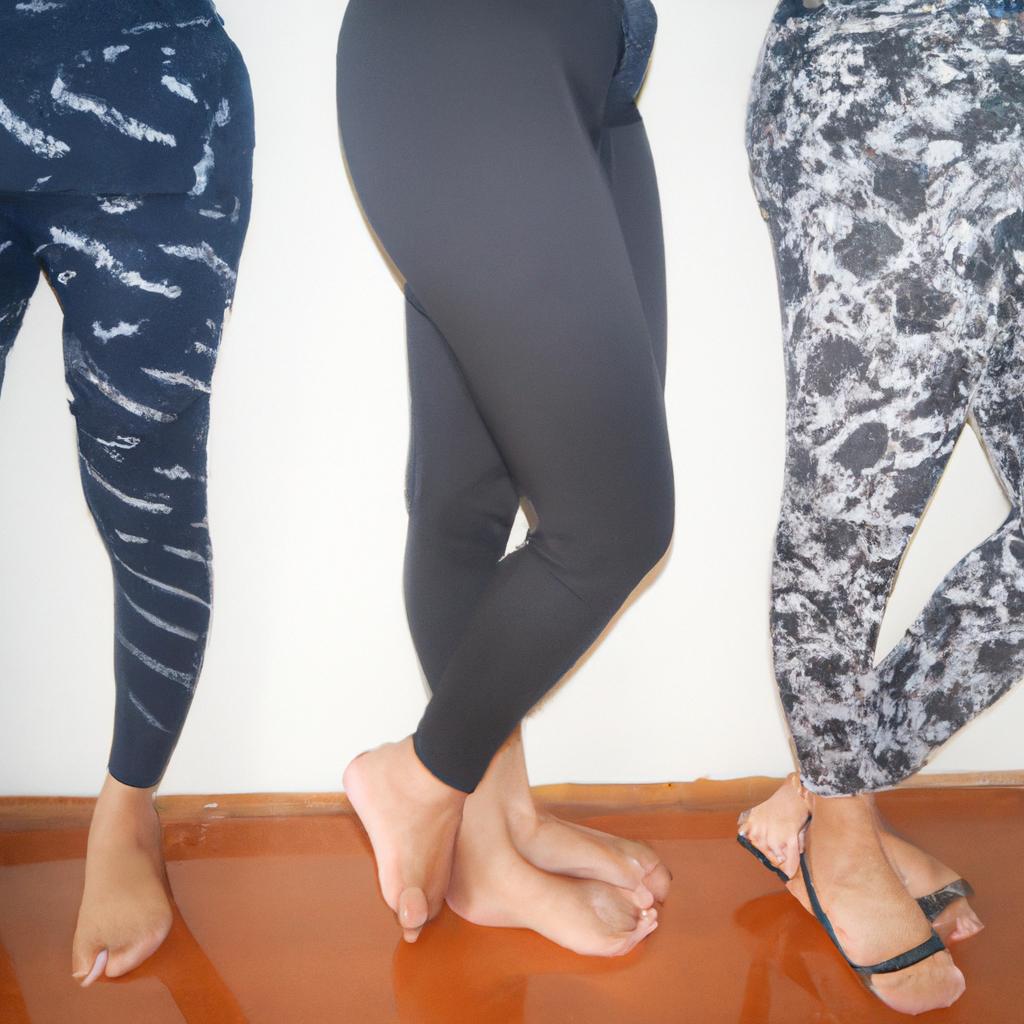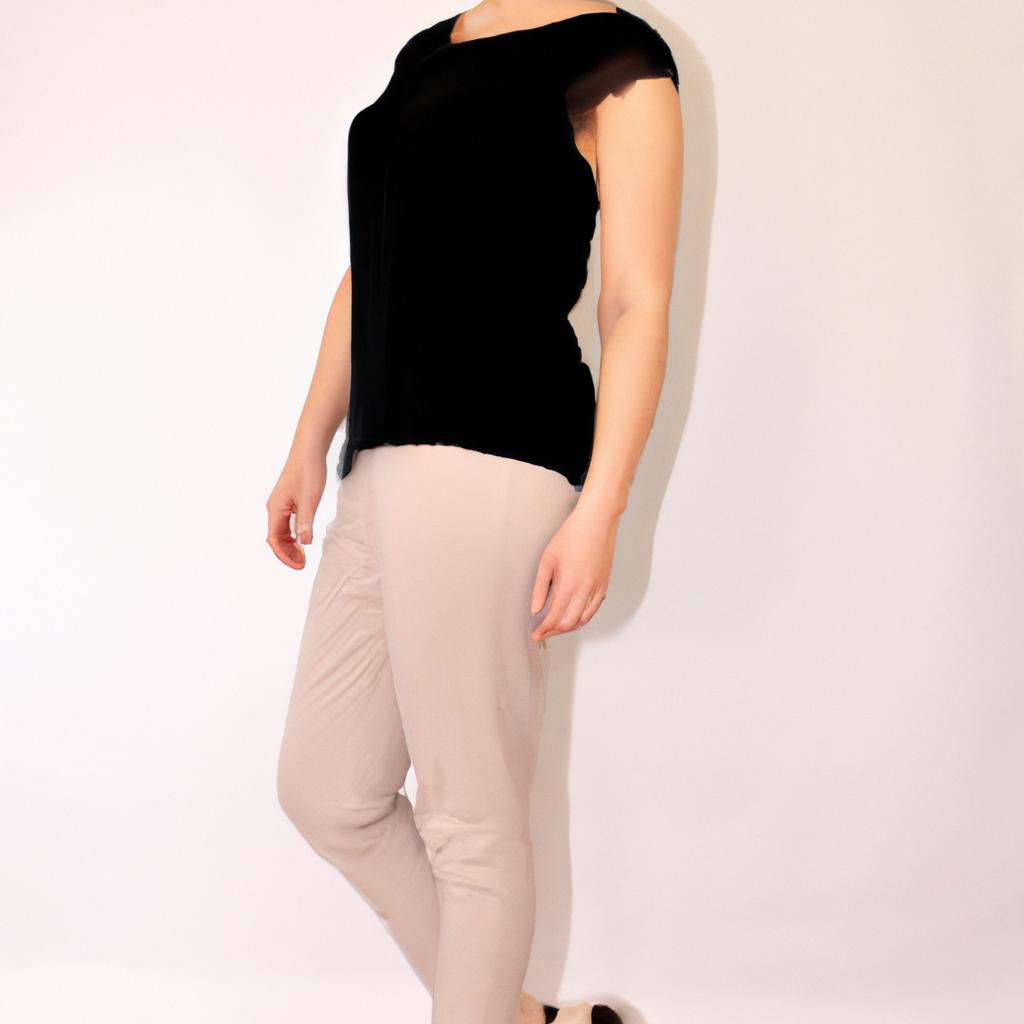Skirts: Women’s Bottoms Unveiled
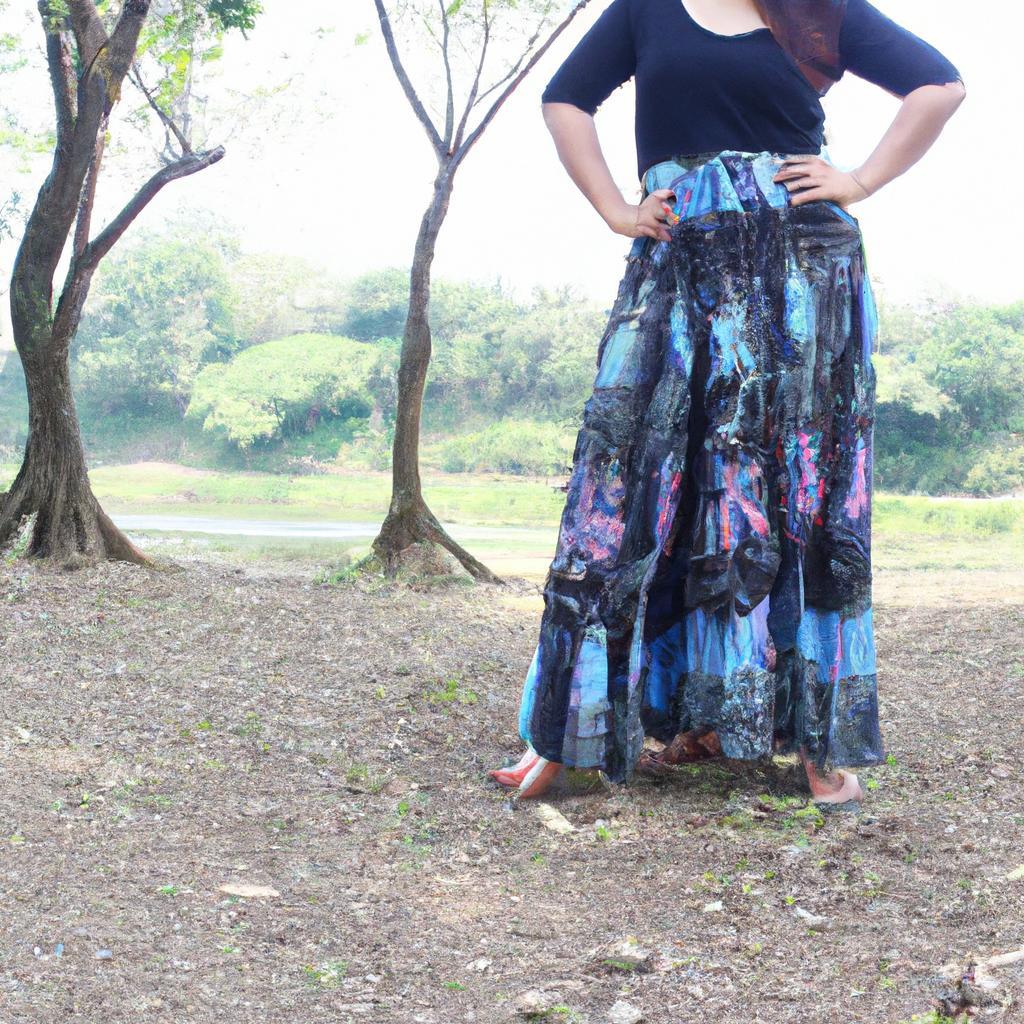
Skirts have long been a staple in women’s fashion, serving as an essential component of their wardrobe. From pencil skirts to maxi skirts, this versatile garment has undergone various transformations throughout history. In examining the evolution of skirts, it becomes evident that they are not merely pieces of fabric worn around the waist; rather, they hold sociocultural significance and reflect changing societal norms and values.
Consider the case study of Emma, a young professional navigating her way through the corporate world. As she prepares for an important business meeting, she carefully selects her outfit with meticulous attention to detail. Her choice of skirt is strategic; she opts for a tailored knee-length skirt in a classic neutral color. This deliberate selection projects professionalism and authority while adhering to workplace dress codes. The skirt becomes emblematic of Emma’s desire to establish herself as a capable and confident individual within her professional sphere.
Throughout history, the design and style of skirts have served as markers of femininity and societal expectations placed upon women. By exploring the historical context behind different types of skirts, we can gain insight into how these garments have influenced concepts such as modesty, class distinctions, and gender roles. Furthermore, analyzing contemporary trends in skirt fashion allows us to understand how society continues to shape women’s fashion choices and how women navigate societal expectations through their clothing.
In recent years, there has been a shift towards more inclusive and diverse representations of femininity in skirt fashion. Designers have embraced the concept of body positivity by creating skirts in a wide range of sizes, lengths, and styles to accommodate different body types and personal preferences. This move towards inclusivity challenges traditional stereotypes about what constitutes a “feminine” silhouette or aesthetic.
Additionally, we see the emergence of skirts that incorporate elements from various cultural traditions, reflecting a growing appreciation for global fashion influences. This trend highlights the interconnectedness of different cultures and allows women to express their identity through their wardrobe choices.
Moreover, the rise of sustainable fashion has also influenced skirt designs. Many brands are now prioritizing environmentally-friendly materials and ethical production practices when creating skirts. This shift reflects society’s increasing awareness of environmental issues and desire for more responsible consumption habits.
Overall, analyzing contemporary skirt fashion reveals how societal values surrounding femininity, diversity, sustainability, and individual expression continue to shape women’s clothing choices. The evolution of skirts not only mirrors changes in fashion trends but also serves as a reflection of broader social shifts and cultural attitudes towards gender roles and personal style.
Types of Skirts
Skirts are a versatile and essential component of women’s fashion. They come in various styles, lengths, and cuts to suit different preferences and occasions. Understanding the types of skirts available can help individuals make informed decisions when selecting the perfect garment for their wardrobe.
To illustrate this point, let us consider the case of Sarah, who recently received an invitation to attend a formal event. Unsure about what type of skirt would be suitable, she embarked on a journey to explore the vast array of options available. Through her exploration, Sarah discovered four distinct categories that captured the essence and diversity of skirts: A-line skirts, pencil skirts, maxi skirts, and pleated skirts.
- A-line skirts: These classic silhouettes feature a fitted waistline that gradually flares out towards the hemline in the shape of an “A.” A-line skirts offer versatility and can be worn for both casual outings or more formal occasions.
- Pencil skirts: Known for their sleek and tailored appearance, pencil skirts hug the body closely from waist to knee. They create a sophisticated look that is often favored in professional settings.
- Maxi skirts: With their floor-length design, maxi skirts exude elegance and grace while providing comfort. Ideal for warm weather or special events, they allow for free movement while adding a touch of femininity.
- Pleated skirts: Characterized by vertical folds sewn into the fabric at regular intervals, pleated skirts add texture and volume. This style has gained popularity due to its playful yet polished aesthetic.
The emotional response evoked by these diverse skirt styles cannot be underestimated. The markdown bullet-point list below showcases some key emotions associated with each type:
- A-line skirt:
- Confidence
- Versatility
- Timeless beauty
- Effortless charm
Now let us delve deeper into understanding these emotions through a three-column table format:
| Skirt Type | Emotion 1 | Emotion 2 | Emotion 3 |
|---|---|---|---|
| A-line skirt | Confidence | Versatility | Timeless beauty |
| Pencil skirt | Elegance | Sophistication | Professionalism |
| Maxi skirt | Comfort | Femininity | Effortlessness |
| Pleated skirt | Playfulness | Polished look | Trendiness |
By acknowledging the emotions associated with each type of skirt, individuals can make more informed choices that align with their personal style and occasion.
Understanding the various types of skirts lays a solid foundation for exploring their rich history. In the following section, we will delve into how these garments have evolved over time, reflecting societal changes and cultural influences.
History of Skirts
Section 2: Types of Skirts
As we delve into the diverse world of skirts, it is essential to understand the various types that exist. Let us begin by examining one such type, the pencil skirt. Picture yourself in a sleek and figure-hugging garment that effortlessly accentuates your curves while maintaining an air of sophistication. The pencil skirt has long been favored for its timeless elegance and versatility.
When exploring the realm of skirts, it becomes evident that there are numerous styles available. To better comprehend this vast array, let us consider four key categories:
-
A-line Skirt:
- Flares out from the waistline, resembling the letter “A.”
- Offers a flattering silhouette for most body shapes.
- Adaptable for both casual and formal occasions.
-
Maxi Skirt:
- Long in length, typically reaching down to the ankles.
- Provides comfort and freedom of movement.
- Suitable for warm weather or when seeking modesty.
-
Pleated Skirt:
- Features multiple folds (pleats) throughout its fabric.
- Adds texture and visual interest to an outfit.
- Often associated with preppy or vintage styles.
-
Wrap Skirt:
- Secures around the waist by wrapping one side over another.
- Allows adjustable fit for different body sizes.
- Exhibits a playful yet sophisticated allure.
To further enhance our understanding, let’s compare these different types using a table:
| Type | Silhouette | Occasion |
|---|---|---|
| A-line | Flattering | Casual and Formal |
| Maxi | Comfortable | Warm Weather |
| Pleated | Textured | Preppy or Vintage Styles |
| Wrap | Adjustable Fit | Playful yet Sophisticated |
By analyzing each category individually and then comparing them side by side, we gain valuable insights into the distinctive characteristics of each skirt type. Understanding these distinctions allows us to make more informed decisions when selecting a style that suits our personal preferences and desired occasion.
As we move forward in exploring skirts, let’s now shift our focus towards the history behind this iconic garment. Unraveling the captivating tales of how skirts have evolved over time will provide us with a deeper appreciation for their significance in fashion through the ages.
With an understanding of various skirt types established, it is now time to explore popular skirt styles and witness how they manifest in contemporary fashion.
Popular Skirt Styles
The history of skirts is a fascinating journey through time, reflecting the ever-changing trends and societal norms. From ankle-length gowns in the Victorian era to miniskirts revolutionizing fashion in the 1960s, skirt lengths have evolved significantly over the years. To illustrate this evolution, let us consider a hypothetical case study of Jane, a young woman exploring different skirt styles throughout her life.
In her teenage years, Jane favored knee-length A-line skirts that allowed her freedom of movement while still adhering to school dress codes. As she progressed into adulthood, pencil skirts became her go-to choice for professional settings, exuding confidence and sophistication. However, as Jane entered her forties and embraced a more relaxed lifestyle, she found herself gravitating towards midi skirts that provided both comfort and style.
Throughout history, various factors influenced changes in skirt lengths. Here are some key contributors:
-
Cultural Shifts: Skirt lengths often mirror cultural shifts and changing perceptions of femininity. For example:
- In the roaring twenties, flapper dresses with shorter hemlines represented women’s newfound liberation.
- During conservative periods like the Victorian era or certain religious traditions, longer skirts were deemed appropriate.
-
Technological Advances: Innovations in textile manufacturing played a significant role in shaping skirt length trends:
- The invention of sewing machines made it easier to create intricate designs on garments.
- Industrialization led to mass production and availability of fabrics at affordable prices.
-
Fashion Icons: Influential figures such as fashion designers or celebrities have frequently dictated popular trends:
- Iconic designer Coco Chanel challenged conventions by introducing knee-length skirts during the 1920s.
- British model Twiggy’s adoption of mini-skirts propelled them into mainstream fashion during the Swinging Sixties.
To further understand these transitions in skirt length preferences over time, refer to the following table:
| Era | Skirt Length | Key Characteristics |
|---|---|---|
| Victorian | Ankle-length | Emphasized modesty and social status |
| Roaring Twenties | Knee-length | Symbolized women’s liberation and rebellion |
| Swinging Sixties | Mini-skirts | Reflected the spirit of youth, freedom, and fun |
| Modern Era | Midi skirts | Combined comfort with elegance in everyday wear |
As we delve into the subsequent section about “Choosing the Right Skirt Length,” it becomes evident that skirt lengths not only follow fashion trends but also serve as a means of self-expression and cultural identity. By understanding the historical context behind these shifts, individuals can make informed choices when selecting their ideal skirt length to suit various occasions.
Choosing the Right Skirt Length
Transitioning smoothly from our exploration of popular skirt styles, let us now delve into the important aspect of selecting the right skirt length. To illustrate its significance, consider a hypothetical scenario where an individual attending a formal event opts for a mini-skirt instead of a floor-length gown. Such a choice might raise eyebrows and potentially diminish their overall appearance in front of others.
When it comes to choosing the appropriate skirt length, there are several factors to consider. Firstly, one must take into account personal style preferences and body proportions. A knee-length pencil skirt suits most body types and is versatile enough for both professional settings and casual outings. On the other hand, maxi skirts can create an elegant and flowy look ideal for summer events or beach parties.
To further guide you in making informed decisions regarding skirt lengths, here are some key considerations:
-
Occasion: Different occasions call for varying levels of formality. For example:
- Formal Events: Opt for longer lengths like midi or full-length skirts.
- Casual Outings: Shorter options such as mini or above-the-knee skirts work well.
- Workplace Settings: Knee-length skirts provide a balance between professionalism and comfort.
-
Body Shape: Understanding your body shape helps determine which length will flatter your figure best:
| Body Type | Suitable Lengths |
|---|---|
| Pear | Flared midis |
| Hourglass | Any |
| Apple | Knee-length |
| Rectangle | Mini/maxi |
-
Weather Conditions: Consider the climate when deciding on skirt length:
- Hot Summers: Opt for shorter styles to stay cool.
- Cold Winters: Pair longer skirts with tights or leggings for added warmth.
-
Personal Comfort: Ultimately, choose a skirt length that makes you feel confident and comfortable. It’s important to wear what aligns with your personal style and preferences.
Transitioning into our next section on Skirt Materials and Fabrics, it is essential to consider the impact of different fabrics in determining the overall look and feel of a skirt. By exploring various materials, we can gain valuable insights into how they affect factors such as drape, durability, and comfort without compromising style. So let’s now embark on an exploration of skirt materials and fabrics.
Note: The table above is a suggestion for formatting purposes only. Please insert relevant content in each cell based on actual information.
Skirt Materials and Fabrics
Transitioning smoothly from the previous section on choosing the right skirt length, let us now delve into the world of skirt materials and fabrics. Understanding different fabric options is essential in selecting a skirt that not only complements your style but also ensures comfort and durability.
Imagine you are attending an outdoor summer wedding where temperatures are soaring. Opting for a flowy maxi skirt made from lightweight chiffon or cotton would be ideal to keep cool while exuding elegance. In contrast, for a professional setting, a pencil skirt crafted from structured wool or polyester blends can add sophistication to your ensemble.
When considering skirt materials and fabrics, several factors come into play:
- Comfort: Choose fabrics that feel comfortable against your skin and allow ease of movement throughout the day.
- Durability: Look for materials that withstand wear and tear without losing their shape or color over time.
- Maintenance: Consider how easy it is to care for the fabric – whether it requires special cleaning methods or can be machine-washed at home.
- Climate-appropriateness: Select textiles that suit the prevailing weather conditions to ensure optimal comfort.
To illustrate further, here is a table comparing common types of skirt materials based on these considerations:
| Material | Comfort | Durability | Maintenance |
|---|---|---|---|
| Cotton | Soft | Moderate | Easy |
| Polyester | Lightweight | High | Simple |
| Silk | Luxurious | Delicate | Requires care |
As seen above, each material has its own set of qualities and characteristics determining its suitability for various occasions and preferences.
In summary, understanding different types of skirt materials empowers individuals to make informed choices based on factors such as comfort, durability, maintenance requirements, and climate appropriateness. With this knowledge in mind, we can move forward to explore styling tips that will enhance our skirts’ overall aesthetic appeal and create stunning outfits for any occasion.
Styling Tips for Skirts
Section H2: Skirt Materials and Fabrics
Skirts come in a variety of materials and fabrics, each offering its unique characteristics and benefits. Understanding the different options available can help you make informed decisions when choosing skirts for your wardrobe. In this section, we will explore some common skirt materials and fabrics, providing insights into their properties and potential applications.
One popular choice among skirt materials is cotton. Known for its breathability and comfort, cotton skirts are ideal for casual wear during warmer seasons. They offer good moisture absorption, allowing air to circulate freely around the body, preventing discomfort caused by perspiration. For example, imagine a woman enjoying a summer picnic in her favorite cotton maxi skirt – she stays cool and comfortable even on hot days.
Another widely used fabric in skirts is polyester. This synthetic material offers several advantages such as durability, wrinkle resistance, and color retention. Polyester skirts are often chosen for their ability to retain shape over time with minimal care required. A hypothetical scenario would be someone attending multiple formal events wearing the same polyester pencil skirt without worrying about it losing its sleek appearance.
In addition to natural fibers like cotton and synthetic ones like polyester, wool is also commonly utilized in skirts. Woolen skirts provide excellent insulation during colder months due to their inherent thermal properties. They effectively trap heat close to the body while still allowing proper airflow. Imagine a professional woman braving the winter weather in a tailored wool skirt – not only does she look stylish but also feels warm throughout her workday.
To summarize the diverse range of materials available for skirts:
- Cotton: Breathable and comfortable; perfect for casual wear.
- Polyester: Durable, wrinkle-resistant, and retains vibrant colors well.
- Wool: Offers excellent insulation against cold temperatures; suitable for professional attire during winter months.
- Other options include silk (luxurious feel), denim (casual yet versatile), and linen (lightweight).
Embrace these various materials and fabrics to curate a versatile skirt collection that caters to different occasions and seasons. Remember, the right choice of material can enhance your comfort, style, and overall confidence.
| Material | Characteristics | Typical Application |
|---|---|---|
| Cotton | Breathable, moisture-absorbent | Casual wear |
| Polyester | Durable, wrinkle-resistant | Formal or everyday wear |
| Wool | Insulating, thermal properties | Professional attire |
By exploring the characteristics of different skirt materials and fabrics, you can make informed decisions when selecting skirts for specific occasions. Consider factors such as climate, purpose, and personal preference to build a well-rounded wardrobe that suits your needs. So go ahead and embrace the variety of options available – let your skirts reflect your unique style while ensuring optimal comfort throughout the year.

